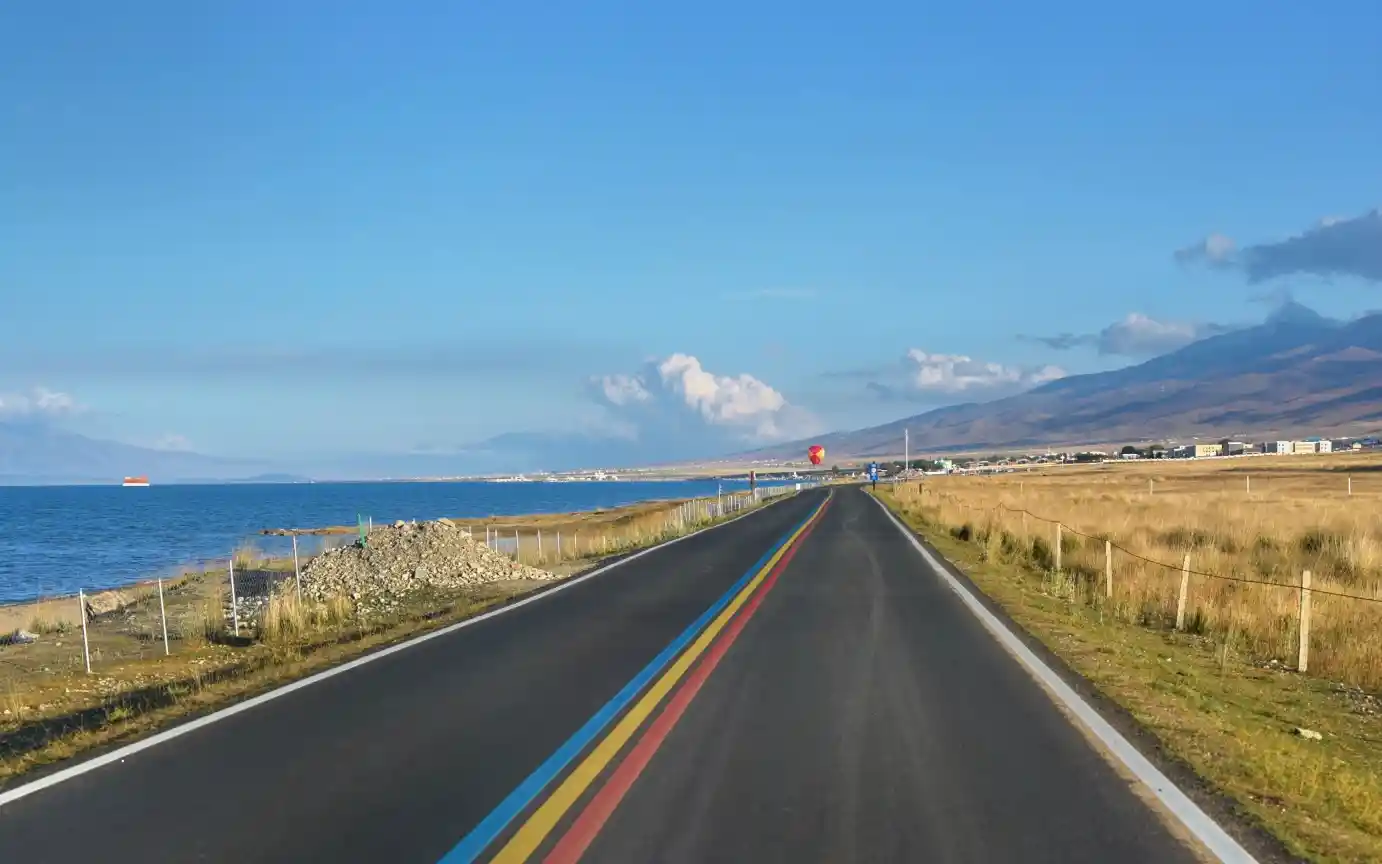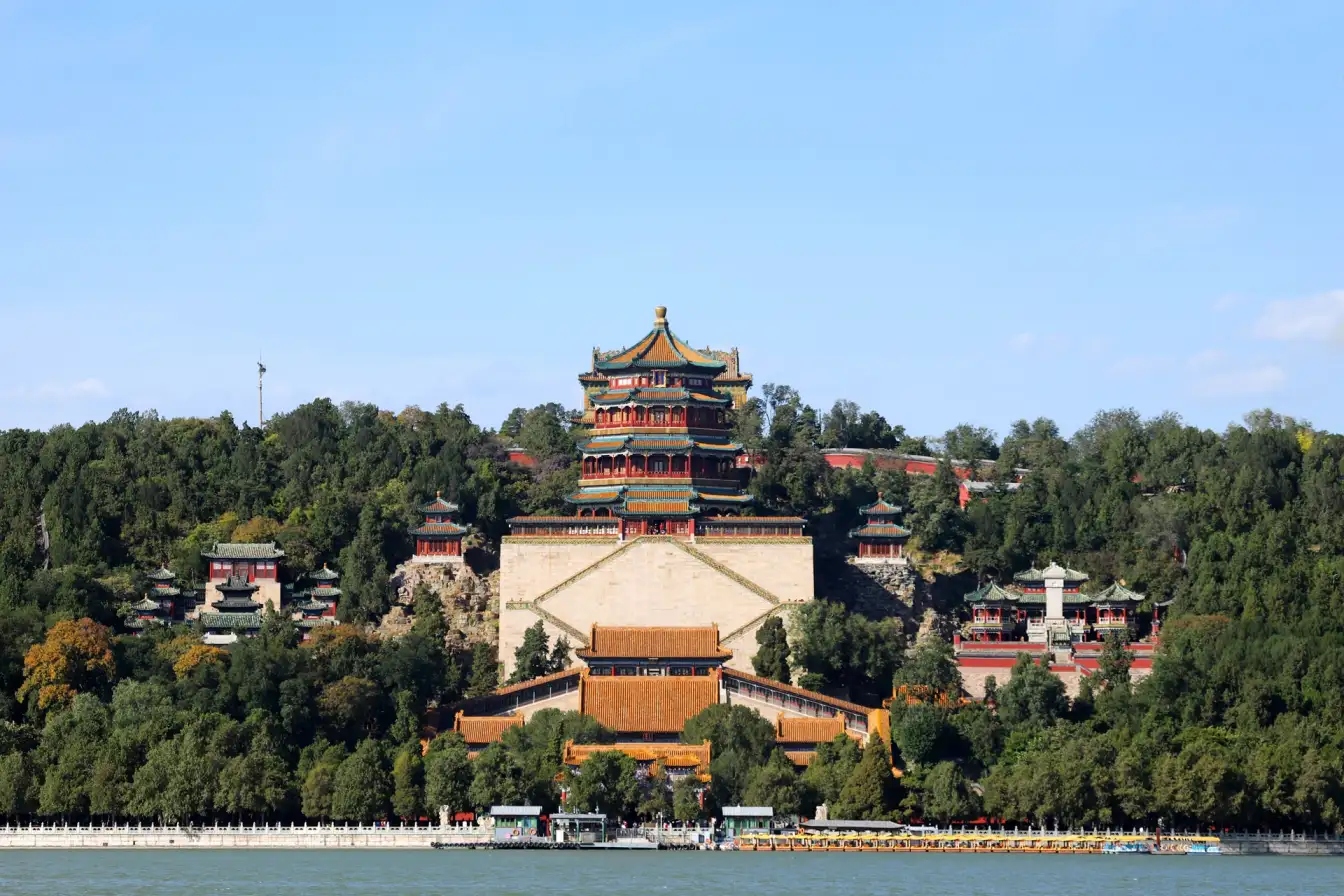
Summer Palace: Beijing's Majestic Imperial Garden in China
1. Location and Overview 🏞️
Location: The Summer Palace (颐和园, Yíhé Yuán) is located in the northwest of Beijing (北京, Běijīng), approximately 15 kilometers (9.3 miles) from the city center.
Overview: The Summer Palace, an expansive ensemble of lakes, gardens, and palaces, is one of the most famous and beautifully preserved imperial gardens in China. Originally constructed in 1750, it served as a luxurious royal retreat during the Qing Dynasty. Spanning 2.9 square kilometers (1.1 square miles), with over 70,000 square meters (753,474 square feet) of building space, this UNESCO World Heritage site is a testament to classical Chinese garden design, blending natural beauty with man-made architectural splendor.
2. Unique Features 🌟
- Kunming Lake (昆明湖, Kūnmíng Hú): Covering about 2.2 square kilometers (0.85 square miles), this large artificial lake is the central feature of the Summer Palace.
- Longevity Hill (万寿山, Wànshòu Shān): Rising 60 meters (197 feet) high, it offers panoramic views of the surrounding landscape and is home to numerous halls, pavilions, and temples.
- The Marble Boat (石舫, Shí Fǎng): A striking pavilion built in the shape of a boat, made entirely of marble.
- Seventeen-Arch Bridge (十七孔桥, Shíqī Kǒng Qiáo): This iconic bridge connects the eastern shore of Kunming Lake to South Lake Island (南湖岛, Nán Hú Dǎo).
- Suzhou Street (苏州街, Sūzhōu Jiē): A picturesque shopping street designed to replicate the canals and market streets of Suzhou.
3. Seasonal Changes 🌷🌞🍁❄️
Spring (March to May): The gardens bloom with cherry blossoms and other flowers, creating a vibrant and colorful landscape. Temperatures are mild and pleasant.
Summer (June to August): The palace is lush and green, with many visitors enjoying boat rides on Kunming Lake. It can be hot and humid, with temperatures often exceeding 30°C (86°F).
Autumn (September to November): This is perhaps the most beautiful season, with cooler temperatures and the changing colors of the leaves. The clear skies and crisp air make it an ideal time to visit.
Winter (December to February): The palace takes on a serene, almost mystical quality with a blanket of snow. The lake often freezes, and the air is cold and dry. Fewer tourists visit during this time.
4. Best Time to Visit ⏰
The best time to visit the Summer Palace is during the autumn months (September to November) when the weather is cool and comfortable, and the fall foliage provides a stunning backdrop to the historical architecture.
5. Travel Tips 🧳✈️
- Early Arrival: To avoid large crowds, especially during weekends and holidays, plan to arrive early in the morning.
- Comfortable Footwear: The Summer Palace is vast, with many paths and steps, so wear comfortable walking shoes.
- Stay Hydrated: Bring water, especially if visiting during the hot summer months.
- Photography: The Summer Palace is a photographer's paradise. However, note that tripods may not be allowed in certain areas.
- Guided Tours: Consider hiring a guide or using an audio guide to gain a deeper understanding of the site’s rich history.
- Rest Areas: There are several spots within the grounds to rest and enjoy the scenery, such as the Pavilion of the Fragrance of Buddha (佛香阁, Fó Xiāng Gé).
6. Cultural Significance 🎭🏯
The Summer Palace is a masterpiece of Chinese landscape garden design, integrating natural landscapes and traditional Chinese architecture. It served as a royal retreat and later as the main residence of the Empress Dowager Cixi in the late Qing Dynasty. The site reflects the artistic style and political power of the Qing Dynasty, representing the pinnacle of traditional Chinese gardening techniques and aesthetics.
7. Tourist Attractions 📸🏞️
- Hall of Benevolence and Longevity (仁寿殿, Rénshòu Diàn): This hall was used for the Empress Dowager Cixi’s government affairs.
- Hall of Jade Ripples (玉澜堂, Yùlán Táng): The residence of Emperor Guangxu.
- The Garden of Virtue and Harmony (德和园, Déhé Yuán): Originally a theater for Cixi, it now displays traditional Chinese performances.
- The Long Corridor (长廊, Cháng Láng): A 728-meter (2,388-foot) covered walkway adorned with thousands of paintings.
- The Tower of Buddhist Incense (佛香阁, Fó Xiāng Gé): Located on Longevity Hill, offering stunning views of the entire palace complex.
- The Hall of Happiness and Longevity (乐寿堂, Lèshòu Táng): Empress Dowager Cixi’s residence.
- Wenchang Gallery (文昌院, Wénchāng Yuàn): An art gallery showcasing imperial treasures.
- Suzhou Street (苏州街, Sūzhōu Jiē): A charming canal-side street with traditional shops and restaurants.
8. Nearby Attractions 🗺️
- Old Summer Palace (圆明园, Yuánmíng Yuán): Also known as the Garden of Perfect Brightness, it is located about 8 kilometers (5 miles) northeast of the Summer Palace.
- Fragrant Hills Park (香山公园, Xiāngshān Gōngyuán): A large forest park famous for its red maple leaves in autumn, located about 10 kilometers (6.2 miles) to the west.
- Beijing Botanical Garden (北京植物园, Běijīng Zhíwù Yuán): A beautiful garden featuring diverse plant species, located near the Fragrant Hills.
- Peking University (北京大学, Běijīng Dàxué): One of China's most prestigious universities, located nearby, offering a beautiful campus for a leisurely walk.
9. How to Get There ✈️🚗🚂
- By Plane: Fly into Beijing Capital International Airport (北京首都国际机场, Běijīng Shǒudū Guójì Jīchǎng) or Beijing Daxing International Airport (北京大兴国际机场, Běijīng Dàxīng Guójì Jīchǎng). From either airport, you can take a taxi or public transport to the Summer Palace.
- By Train: Beijing has multiple railway stations including Beijing Railway Station (北京站, Běijīng Zhàn), Beijing West Railway Station (北京西站, Běijīng Xī Zhàn), and Beijing South Railway Station (北京南站, Běijīng Nán Zhàn). From these stations, you can take the subway or a taxi.
- By Subway: Take Beijing Subway Line 4 and get off at Beigongmen Station (北宫门站, Běigōngmén Zhàn) or Xiyuan Station (西苑站, Xīyuàn Zhàn).
- By Bus: Numerous bus lines such as 330, 331, 332, 346, and 696 serve the Summer Palace. Check local timetables for details.
- By Taxi: Taxis are readily available throughout Beijing. Ensure the driver uses the meter for a fair fare.
- By Car Rental: Renting a car is possible, but Beijing’s traffic can be challenging. Using GPS is essential for accurate navigation.
10. Practical Information 💼💰
- Ticket Price: Entrance fees are approximately 30 RMB (about $4.50 USD) in the low season and 60 RMB (about $9 USD) in the high season. Additional charges apply for certain areas such as the Tower of Buddhist Incense.
- Opening Hours: Typically open from 6:30 AM to 6:00 PM (April to October) and from 7:00 AM to 5:00 PM (November to March). Specific attractions within the Summer Palace may have different hours.
- Free Entry: On certain days or for specific groups, free entry may be available. Check the official website for details.
- Audio Guides: Available in multiple languages, including English, for a more detailed exploration.
11. Local Cuisine 🍲🥢
- Beijing Roast Duck (北京烤鸭, Běijīng Kǎoyā): Famous for its crispy skin, served with thin pancakes, scallions, and sweet bean sauce.
- Zhajiangmian (炸酱面, Zhàjiàngmiàn): Wheat noodles topped with a savory soybean paste sauce.
- Baozi (包子, Bāozi): Steamed buns filled with various fillings like pork, beef, or vegetables.
- Peking Hotpot (北京火锅, Běijīng Huǒguō): A communal dining experience where diners cook their food in a shared pot of simmering broth.
- Jianbing (煎饼, Jiānbǐng): A popular Chinese street food, often enjoyed for breakfast. It is a savory crepe with egg, scallions, and various fillings.
- Tanghulu (糖葫芦, Tánghúlu): Candied fruits on a stick, commonly hawthorn, but also available with strawberries and other fruits.
12. Precautions to Take ⚠️
- Crowds: The Summer Palace can get very crowded, especially during weekends and holidays. Arrive early to avoid the peak times.
- Sun Protection: During summer, wear sunscreen, a hat, and sunglasses to protect against the sun.
- Hydration: Bring plenty of water, as exploring the palace grounds can be exhausting.
- Walking: Be prepared for a lot of walking, including climbing stairs and navigating uneven surfaces.
- Security: Keep an eye on your belongings and be aware of pickpockets in crowded areas.
- Weather: Check the weather forecast and dress appropriately for the season. Beijing can be very hot in summer and extremely cold in winter.
- Respect: Show respect for the cultural and historical significance of the site by not touching artifacts and following posted rules.
13. Conclusion 🌟
The Summer Palace is a must-visit destination in Beijing, offering a perfect blend of natural beauty, historical architecture, and cultural significance. Whether you're strolling along the Long Corridor, taking in the views from Longevity Hill, or simply enjoying a peaceful boat ride on Kunming Lake, the Summer Palace provides an unforgettable experience for any traveler. Plan your visit to this imperial garden to truly appreciate the grandeur and history of one of China's most beloved landmarks.














Comments
Leave a reply